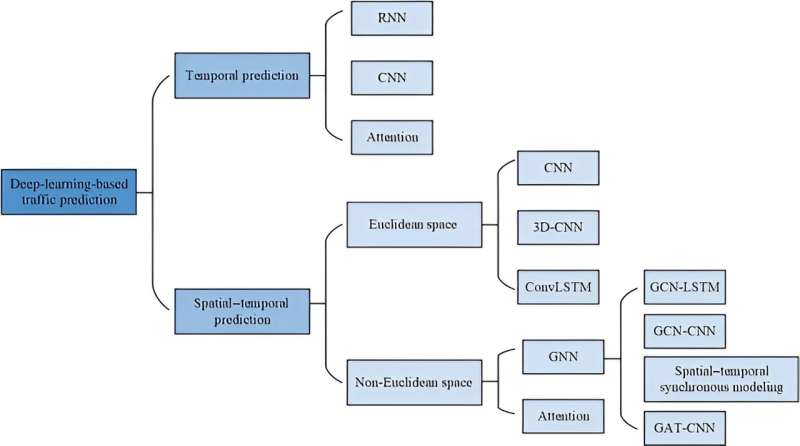This article has been reviewed according to Science X's editorial process and policies. Editors have highlighted the following attributes while ensuring the content's credibility:
fact-checked
trusted source
proofread
New survey on deep learning solutions for cellular traffic prediction

The bustling streets of a modern city are filled with countless individuals using their smartphones for streaming videos, sending messages and browsing the web. In the era of rapidly expanding 5G networks and the omnipresence of mobile devices, the management of cellular traffic has become increasingly complex.
To address this challenge, mobile network operators need methods for the accurate prediction of cellular traffic. A comprehensive survey published in Intelligent Computing explores deep learning techniques for cellular traffic prediction.
Better cellular traffic prediction would enhance intelligent 5G network construction and resource management, thereby improving the quality of experience for users. According to the review, cellular traffic prediction has three main applications. It is used to:
- Optimize routing to improve quality of service by reducing packet loss and latency;
- Schedule traffic flow generated by the Internet of Things devices through adaptive traffic optimization to improve mobile network utilization;
- Reduce latency and minimize power consumption by optimizing resource allocation.
Cellular traffic prediction involves forecasting traffic values using historical data. According to the review, cellular traffic prediction problems can be classified into two main types: temporal and spatial–temporal.
Temporal prediction focuses on predicting the traffic flow of an individual network element, such as a single base station, using only its own historical traffic data. In contrast, spatial-temporal prediction aims to predict the traffic data of multiple network elements that have spatial dependencies.
Temporal prediction methods
- Recurrent neural networks are widely used for handling time-series data. However, gradients, which are crucial for learning and optimization, may become too small or too large. Long short-term memory networks address this problem by introducing gating mechanisms to regulate information flow, but the added complexity may affect overall performance.
- Convolutional neural networks, initially designed for image processing, are simpler and faster than long short-term memory networks. They leverage 1D convolutions to analyze traffic patterns over different time scales.
- Attention-based methods offer advancements in capturing complex patterns within sequential data. They focus on determining the association between input vectors, enabling the model to prioritize relevant information for prediction using attention scores.
Spatial-temporal prediction methods
- Grid-based methods are utilized for modeling spatial correlations of traffic data in Euclidean space. Traffic data organized in grids resembles images, enabling the use of convolutional neural networks for prediction. Grid-based approaches may struggle with precise network element-level predictions due to the coarse granularity of the typical grid topology.
- Graph-based methods, particularly graph convolutional networks, enable the modeling of detailed spatial relationships in cellular traffic data. However, they require careful graph construction, and training can be computationally intensive.
- Attention-based methods have gained popularity among researchers due to their parallelizability and ability to improve training effectiveness. They excel at exploring global relationships in data by assigning distinct weight parameters to input objects, emphasizing relevant data, and suppressing irrelevant data.
Some challenges may still exist, and they will be potential research areas in cellular traffic prediction. First, data quality issues such as missing, noisy, and anomalous data may affect the accuracy of predictions. Second, protecting user privacy while making accurate predictions is a growing concern. Third, modeling the spatial–temporal correlation of traffic data is a complex problem that requires a deep understanding and simulation of the interdependence of data in time and space.
Fourth, the geographic locations, user groups, surrounding environments, and network devices among different wireless base stations result in the heterogeneity of network traffic, posing additional challenges to traffic prediction in large-scale cellular networks. Finally, the accuracy of long-term traffic prediction remains an issue that requires further research.
Future directions for research in the field of cellular traffic prediction include establishing benchmarking frameworks for fair model comparison and embracing external factor modeling to enhance prediction accuracy. Moreover, it is essential to generalize models across tasks and facilitate decentralized collaboration while ensuring data privacy.
Transfer learning enables models to leverage knowledge from related tasks, thereby eliminating the need for training from scratch. Federated learning allows participants to jointly model without sharing data, addressing data islands and limiting the risk of data leakage. Finally, enhancing model interpretability could offer insight into the implementation of cellular traffic prediction algorithms.
More information: Xing Wang et al, A Survey on Deep Learning for Cellular Traffic Prediction, Intelligent Computing (2023). DOI: 10.34133/icomputing.0054


















